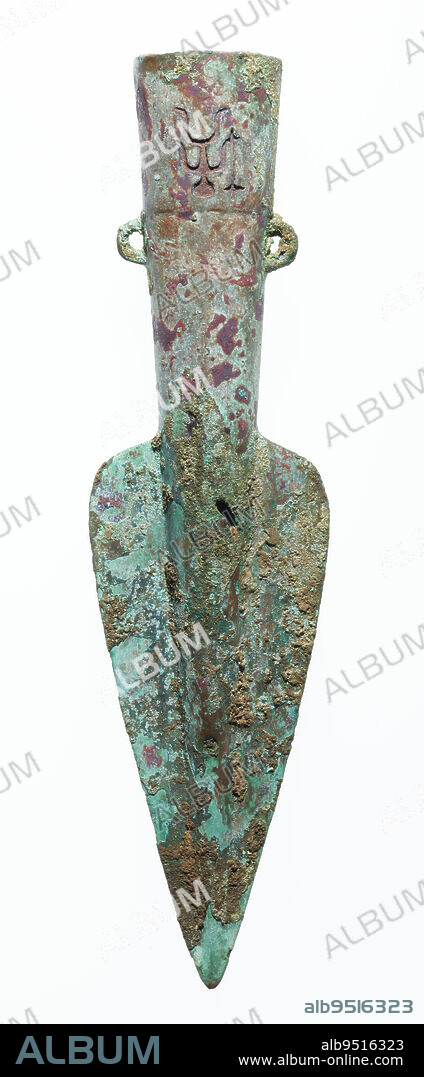alb9516323
Spearhead (mao), late 13th century BCE, 7 3/4 × 2 1/16 × 1 1/16 in. (19.69 × 5.24 × 2.7 cm), Bronze, China, 13th century BCE, Two inscribed Shang dynasty bronze spearheads dating to the Anyang period (thirteenth to mid-eleventh century BCE). Each has a flat, leaf-shaped blade with a single point and double edges on a tapered, hollow socket with a pair of loops above the reinforced rim for fixing to a shaft. Spearheads resembling this pair were excavated from tomb M54 at Huayuanzhuang-dong in Anyang, datable to Phase II of the Anyang period which is contemporary to the famous Tomb of Fuhao, the consort of King Wuding, who died around 1200 BCE. The ears on the bronze spearheads were used to fix them onto a shaft. From the Western Zhou onward, perforations and nail holes were used as the principal method of fastening. Bronze spears were prevalent during Shang times since battles were primarily fought on foot, but they became less common in the Western Zhou and later as chariot warfare became more common.

|
Añadir a otro lightbox |
|
Añadir a otro lightbox |



¿Ya tienes cuenta? Iniciar sesión
¿No tienes cuenta? Regístrate
Compra esta imagen.
Selecciona el uso:

Descripción:
Ver traducción automática
Spearhead (mao), late 13th century BCE, 7 3/4 × 2 1/16 × 1 1/16 in. (19.69 × 5.24 × 2.7 cm), Bronze, China, 13th century BCE, Two inscribed Shang dynasty bronze spearheads dating to the Anyang period (thirteenth to mid-eleventh century BCE). Each has a flat, leaf-shaped blade with a single point and double edges on a tapered, hollow socket with a pair of loops above the reinforced rim for fixing to a shaft. Spearheads resembling this pair were excavated from tomb M54 at Huayuanzhuang-dong in Anyang, datable to Phase II of the Anyang period which is contemporary to the famous Tomb of Fuhao, the consort of King Wuding, who died around 1200 BCE. The ears on the bronze spearheads were used to fix them onto a shaft. From the Western Zhou onward, perforations and nail holes were used as the principal method of fastening. Bronze spears were prevalent during Shang times since battles were primarily fought on foot, but they became less common in the Western Zhou and later as chariot warfare became more common.
Crédito:
Album / quintlox
Autorizaciones:
Tamaño imagen:
3610 x 8728 px | 90.1 MB
Tamaño impresión:
30.6 x 73.9 cm | 12.0 x 29.1 in (300 dpi)
Palabras clave:
ANYANG • ARREGLAR • BATALLAS • BRONCE • BRONZE • BUCLES • CHINA • COMUNES • CONICO • CONSORTE • CONTEMPORÁNEO • EJE • FIJACION • FOOT • LATER • MURIO • OBRA DE BRONCE • OÍDOS • PERFORACIONES • PIE • PUNTA DE LANZA • QUE SE FIJAN • REPARACION • REPARAR
 Pinterest
Pinterest Twitter
Twitter Facebook
Facebook Copiar enlace
Copiar enlace Email
Email
